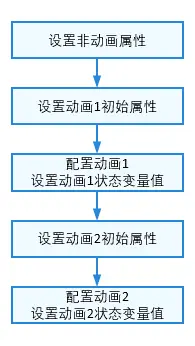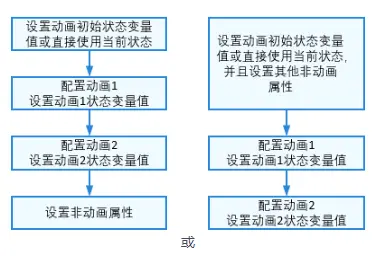鸿蒙(HarmonyOS)性能优化实战-应用程序动效能力实践
本文介绍如何在开发应用程序时合理地使用动效,来获得更好的性能。主要通过减少布局和属性的变更频次,避免冗余刷新,从而降低性能开销。组件转场动画使用transition组件布局改动时使用图形变换属性动画动画参数相同时使用同一个animateTo多次animateTo时统一更新状态变量如果你觉得这篇内容对你还蛮有帮助,我想邀请你帮我三个小忙:关注小编,同时可以期待后续文章ing🚀,不定期分享原创知识。
概述
本文介绍如何在开发应用程序时合理地使用动效,来获得更好的性能。主要通过减少布局和属性的变更频次,避免冗余刷新,从而降低性能开销。
基于上述考虑,提供四种较为推荐的动效实现方式:
- 组件转场动画使用transition
- 组件布局改动时使用图形变换属性动画
- 动画参数相同时使用同一个animateTo
- 多次animateTo时统一更新状态变量
合理使用动效
组件转场动画使用transition
在实现组件出现和消失的动画效果时,通常有两种方式:
- 使用组件动画(animateTo),并在在动画结束回调中增加逻辑处理。
- 直接使用转场动画(transition)。
animateTo需要在动画前后做两次属性更新,而transition只需做一次条件改变更新,性能更好。此外,使用transition,可以避免在结束回调中做复杂逻辑处理,开发实现更容易。因此,推荐优先使用transition。
反例:通过改变透明度属性,从1到0进行隐藏,并在动画结束回调中控制组件的消失。
@Entry
@Component
struct MyComponent {
@State mOpacity: number = 1;
@State show: boolean = true;
count: number = 0;
build() {
Column() {
Row() {
if (this.show) {
Text('value')
.opacity(this.mOpacity)
}
}
.width('100%')
.height(100)
.justifyContent(FlexAlign.Center)
Text('toggle state')
.onClick(() => {
this.count++;
const thisCount: number = this.count;
this.show = true;
// 通过改变透明度属性,对Text控件做隐藏或出现的动画
animateTo({ duration: 1000, onFinish: () => {
// 在最后一个动画中,先让Text控件隐藏,再改变条件让Text控件消失
if (thisCount === this.count && this.mOpacity === 0) {
this.show = false;
}
} }, () => {
this.mOpacity = this.mOpacity === 1 ? 0 : 1;
})
})
}
}
}
正例:直接使用转场动画,实现Text控件透明度的出现与消失。
@Entry
@Component
struct MyComponent {
@State show: boolean = true;
build() {
Column() {
Row() {
if (this.show) {
Text('value')
// 设置id,使转场可打断
.id('myText')
.transition(TransitionEffect.OPACITY.animation({ duration: 1000 }))
}
}.width('100%')
.height(100)
.justifyContent(FlexAlign.Center)
Text('toggle state')
.onClick(() => {
// 通过transition,做透明度的出现或消失动画
this.show = !this.show;
})
}
}
}
组件布局改动时使用图形变换属性动画
改动组件的布局显示有两种方式:
- 改动布局属性。当布局属性发生改变时,界面将重新布局。常见的布局属性有width、height、layoutWeight等。
- 改动图形变换属性。图形变换是对组件布局结果的变换操作,如平移、旋转、缩放等操作。
界面布局是非常耗时的操作,而当图形变换属性发生变化时,并不会重新触发布局。因此,优先推荐使用图形变换属性来实现组件布局的改动。接下来,采用上述两种方式分别对组件实现放大10倍的效果。
反例:通过设置布局属性width和height,改变组件大小。
@Entry
@Component
struct MyComponent {
@State textWidth: number = 10;
@State textHeight: number = 10;
build() {
Column() {
Text()
.backgroundColor(Color.Blue)
.fontColor(Color.White)
.fontSize(20)
.width(this.textWidth)
.height(this.textHeight)
Button('布局属性')
.backgroundColor(Color.Blue)
.fontColor(Color.White)
.fontSize(20)
.margin({ top: 30 })
.borderRadius(30)
.padding(10)
.onClick(() => {
animateTo({ duration: 1000 }, () => {
this.textWidth = 100;
this.textHeight = 100;
})
})
}
}
}
在对组件位置或大小变化做动画时,由于布局属性的改变会触发重新测量布局,导致性能开销大。scale属性的改变不会重新触发测量布局,性能开销小。因此,在组件位置大小持续发生变化的场景,如手指缩放的动画场景,推荐使用scale。
正例:通过设置图形变换属性scale,改变组件大小。
@Entry
@Component
struct MyComponent {
@State textScaleX: number = 1;
@State textScaleY: number = 1;
build() {
Column() {
Text()
.backgroundColor(Color.Blue)
.fontColor(Color.White)
.fontSize(20)
.width(10)
.height(10)
.scale({ x: this.textScaleX, y: this.textScaleY })
.margin({ top: 100 })
Button('图形变换属性')
.backgroundColor(Color.Blue)
.fontColor(Color.White)
.fontSize(20)
.margin({ top: 60 })
.borderRadius(30)
.padding(10)
.onClick(() => {
animateTo({ duration: 1000 }, () => {
this.textScaleX = 10;
this.textScaleY = 10;
})
})
}
}
}
动画参数相同时使用同一个animateTo
每次animateTo都需要进行动画前后的对比,因此,减少animateTo的使用次数(例如使用同一个animateTo设置组件属性),可以减少该组件更新的次数,从而获得更好的性能。
如果各个属性要做动画的参数相同,推荐将它们放到同一个动画闭包中执行。
反例:相同动画参数的状态变量更新放在不同的动画闭包中。
@Entry
@Component
struct MyComponent {
@State textWidth: number = 200;
@State color: Color = Color.Red;
func1() {
animateTo({ curve: Curve.Sharp, duration: 1000 }, () => {
this.textWidth = (this.textWidth === 100 ? 200 : 100);
});
}
func2() {
animateTo({ curve: Curve.Sharp, duration: 1000 }, () => {
this.color = (this.color === Color.Yellow ? Color.Red : Color.Yellow);
});
}
build() {
Column() {
Row()
.width(this.textWidth)
.height(10)
.backgroundColor(this.color)
Text('click')
.onClick(() => {
this.func1();
this.func2();
})
}
.width('100%')
.height('100%')
}
}
正例:将相同动画参数的动画合并在一个动画闭包中。
@Entry
@Component
struct MyComponent {
@State textWidth: number = 200;
@State color: Color = Color.Red;
func() {
animateTo({ curve: Curve.Sharp, duration: 1000 }, () => {
this.textWidth = (this.textWidth === 100 ? 200 : 100);
this.color = (this.color === Color.Yellow ? Color.Red : Color.Yellow);
});
}
build() {
Column() {
Row()
.width(this.textWidth)
.height(10)
.backgroundColor(this.color)
Text('click')
.onClick(() => {
this.func();
})
}
.width('100%')
.height('100%')
}
}
多次animateTo时统一更新状态变量
animateTo会将执行动画闭包前后的状态进行对比,对差异部分进行动画。为了对比,会在执行animateTo的动画闭包之前,将所有变更的状态变量和脏节点都刷新。
如果多个animateTo之间存在状态更新,会导致执行下一个animateTo之前又存在需要更新的脏节点,可能造成冗余更新。
反例:多个animateTo之间更新状态变量。

以下代码在两个animateTo之间更新组件的其他状态。
@Entry
@Component
struct MyComponent {
@State textWidth: number = 200;
@State textHeight: number = 50;
@State color: Color = Color.Red;
build() {
Column() {
Row()
.width(this.textWidth)
.height(10)
.backgroundColor(this.color)
Text('click')
.height(this.textHeight)
.onClick(() => {
this.textWidth = 100;
// textHeight是非动画属性
this.textHeight = 100;
animateTo({ curve: Curve.Sharp, duration: 1000 }, () => {
this.textWidth = 200;
});
this.color = Color.Yellow;
animateTo({ curve: Curve.Linear, duration: 2000 }, () => {
this.color = Color.Red;
});
})
}
.width('100%')
.height('100%')
}
}
在第一个animateTo前,重新设置了textWidth属性,所以Row组件需要更新一次。在第一个animateTo的动画闭包中,改变了textWidth属性,所以Row组件又需要更新一次并对比产生宽高动画。第二个animateTo前,重新设置了color属性,所以Row组件又需要更新一次。在第二个animateTo的动画闭包中,改变了color属性,所以Row组件再更新一次并产生了背景色动画。Row组件总共更新了4次属性。
此外还更改了与动画无关的状态textHeight,如果不需要改变无关状态,则不应改变造成冗余更新。
正例:统一更新状态变量。

正例1:在animateTo之前使用原始状态,让动画从原始状态过渡到指定状态,这样也能避免动画在开始时发生跳变。
@Entry
@Component
struct MyComponent {
@State textWidth: number = 100;
@State textHeight: number = 50;
@State color: Color = Color.Yellow;
build() {
Column() {
Row()
.width(this.textWidth)
.height(10)
.backgroundColor(this.color)
Text('click')
.height(this.textHeight)
.onClick(() => {
animateTo({ curve: Curve.Sharp, duration: 1000 }, () => {
this.textWidth = (this.textWidth === 100 ? 200 : 100);
});
animateTo({ curve: Curve.Linear, duration: 2000 }, () => {
this.color = (this.color === Color.Yellow ? Color.Red : Color.Yellow);
});
})
}
.width('100%')
.height('100%')
}
}
在第一个animateTo之前,不存在需要更新的脏状态变量和脏节点,无需更新。在第一个animateTo的动画闭包中,改变了textWidth属性,所以Row组件需要更新一次并对比产生宽高动画。在第二个animateTo之前,由于也没有执行额外的语句,不存在需要更新的脏状态变量和脏节点,无需更新。在第二个animateTo的动画闭包中,改变了color属性,所以Row组件再更新一次并产生了背景色动画。Row组件总共更新了2次属性。
正例2:在animateTo之前显式的指定所有需要动画的属性初值,统一更新到节点中,然后再做动画。
@Entry
@Component
struct MyComponent {
@State textWidth: number = 200;
@State textHeight: number = 50;
@State color: Color = Color.Red;
build() {
Column() {
Row()
.width(this.textWidth)
.height(10)
.backgroundColor(this.color)
Text('click')
.height(this.textHeight)
.onClick(() => {
this.textWidth = 100;
this.color = Color.Yellow;
animateTo({ curve: Curve.Sharp, duration: 1000 }, () => {
this.textWidth = 200;
});
animateTo({ curve: Curve.Linear, duration: 2000 }, () => {
this.color = Color.Red;
});
this.textHeight = 100;
})
}
.width('100%')
.height('100%')
}
}
在第一个animateTo之前,重新设置了textWidth和color属性,所以Row需要更新一次。在第一个animateTo的动画闭包中,改变了textWidth属性,所以Row组件需要更新一次并对比产生宽高动画。在第二个animateTo之前,由于没有执行额外的语句,不存在需要更新的脏状态变量和脏节点,无需更新。在第二个animateTo的动画闭包中,改变了color属性,所以Row组件再更新一次并产生了背景色动画。Row组件总共更新了3次属性。
为了能让大家更好的学习鸿蒙(HarmonyOS NEXT)开发技术,这边特意整理了《鸿蒙开发学习手册》(共计890页),希望对大家有所帮助:https://qr21.cn/FV7h05
《鸿蒙开发学习手册》:
如何快速入门:https://qr21.cn/FV7h05
- 基本概念
- 构建第一个ArkTS应用
- ……

开发基础知识:https://qr21.cn/FV7h05
- 应用基础知识
- 配置文件
- 应用数据管理
- 应用安全管理
- 应用隐私保护
- 三方应用调用管控机制
- 资源分类与访问
- 学习ArkTS语言
- ……

基于ArkTS 开发:https://qr21.cn/FV7h05
- Ability开发
- UI开发
- 公共事件与通知
- 窗口管理
- 媒体
- 安全
- 网络与链接
- 电话服务
- 数据管理
- 后台任务(Background Task)管理
- 设备管理
- 设备使用信息统计
- DFX
- 国际化开发
- 折叠屏系列
- ……

鸿蒙开发面试真题(含参考答案):https://qr18.cn/F781PH

鸿蒙开发面试大盘集篇(共计319页):https://qr18.cn/F781PH
1.项目开发必备面试题
2.性能优化方向
3.架构方向
4.鸿蒙开发系统底层方向
5.鸿蒙音视频开发方向
6.鸿蒙车载开发方向
7.鸿蒙南向开发方向

写在最后
- 如果你觉得这篇内容对你还蛮有帮助,我想邀请你帮我三个小忙:
- 点赞,转发,有你们的 『点赞和评论』,才是我创造的动力。
- 关注小编,同时可以期待后续文章ing🚀,不定期分享原创知识。
- 想要获取更多完整鸿蒙最新学习资源,请移步前往小编:
https://gitee.com/MNxiaona/733GH

更多推荐
 已为社区贡献50条内容
已为社区贡献50条内容









所有评论(0)